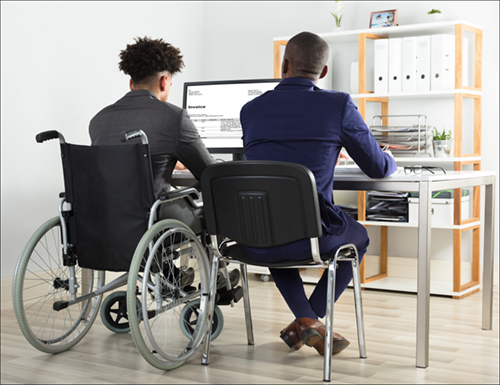Recommendations and Resources to Assist Agencies in Identifying and Advancing Priorities for Facility Accessibility

The U.S. Access Board (“Access Board” or “Board”) has several key responsibilities that support making the federal government a model of accessibility. These include establishing and maintaining minimum accessibility guidelines under the Architectural Barriers Act of 1968 (ABA) and ensuring federal agency compliance with the ABA through enforcement and the provision of technical assistance and training.
The Access Board has developed this set of recommendations and resources to aid agencies in drafting the portions of their strategic plans required under Executive Order 14035 dealing with accessibility. The Access Board recommends that agencies’ strategic plans take all, or as many as possible, of the following actions to promote and enhance facility accessibility:
- Communicate a clear public commitment by agency leadership to prioritize the accessibility of agency facilities for individuals with disabilities (both employees and visitors).
- In e-mail communications to employees, on bulletin boards where other legally required notices are posted, and on accessibility statements on agency websites, include information on how individuals can file ABA complaints with the Access Board by visiting its Filing a Complaint webpage.
- Specify a high-level official in each agency responsible for facility accessibility. Ideally, this should be the individual’s primary responsibility. All new construction or alteration projects should be approved by this individual to ensure accessibility is properly addressed.
- Establish and execute a plan, with timeframes and milestones, for assessing the accessibility of ABA-covered agency facilities to ensure that the minimum requirements in the applicable ABA accessibility standards are met.
- In facilities where the General Services Administration leases space (or is preparing to execute a new lease) on behalf of the agency, assess facilities using the GSA Accessibility Compliance Checklist for Leased Facilities. Where violations are discovered, agencies should work with their GSA facility/leasing contact(s) to ensure that issues are brought to their attention and resolved.
- If an employee in, or visitor to, a leased facility reports a barrier to physical accessibility, agencies should make their GSA facility/leasing contact(s) aware of the barrier and request assistance with remediating it.
- For agency-owned facilities that will be built, ensure that the applicable accessibility requirements are considered during all phases of the construction process, including in the initial design stage.
- Wherever possible, go beyond minimum requirements in the ABA accessibility standards.
- Consider which universal/inclusive design best practices could be implemented in each workplace to afford the greatest amount of access and reduce the need for reasonable accommodation requests.
- Even at facilities not covered by the ABA (e.g., those built prior to 1968 that have not been altered since), ensure, wherever possible, that facilities comply with at least the minimum requirements set forth in the ABA accessibility standards, and exceed those requirements to the maximum extent feasible.
- Ensure that existing accessible elements, such as elevators, platform lifts, and assistive listening systems, are properly maintained and kept in good working order.
- Ensure that accessible routes and circulation paths, as well as access to accessible elements, are kept clear of obstructions such as trashcans, surplus furniture, copiers and other devices, and other clutter.
- Ensure that all individuals involved in facility design, construction, and maintenance are aware of the technical assistance and training services provided by the Access Board on the ABA. See the following links:
- A user-friendly and accessible online version of the ABA Accessibility Standards;
- Guides to the ABA Accessibility Standards;
- Animations that further explain certain requirements;
- Webinar Series on the Standards – Upcoming Webinars and Archived Webinars;
- In-person and virtual training sessions (continuing education credits available through some sessions) – e-mail training@access-board.gov to request training;
- A toll-free technical assistance phone line – 1-800-872-2253 (voice) or 1-800-993-2822 (TTY); and
- A dedicated technical assistance e-mail address – ta@access-board.gov.
Note: In addition to facility accessibility, agencies should also ensure that their DEIA plans address the accessibility of information and communication technology (ICT). The General Services Administration (GSA) has developed the following relevant resources: section508.gov/manage/deia-guidance. The Access Board also provides Section 508 resources (access-board.gov/ict) and a Section 508 Webinar (www.accessibilityonline.org/cioc-508/schedule/). E-mail 508@access-board.gov for additional information.

